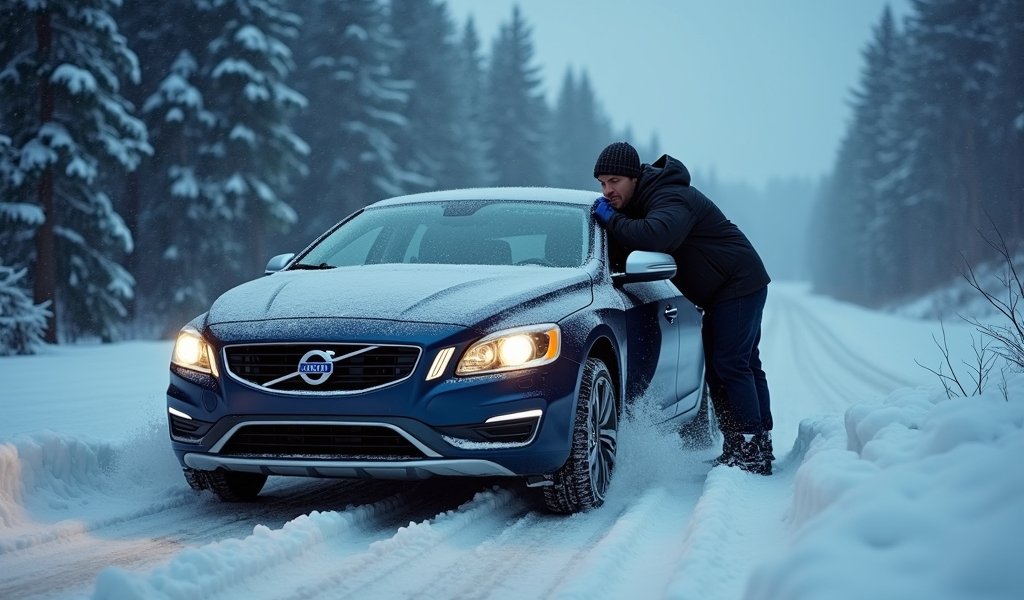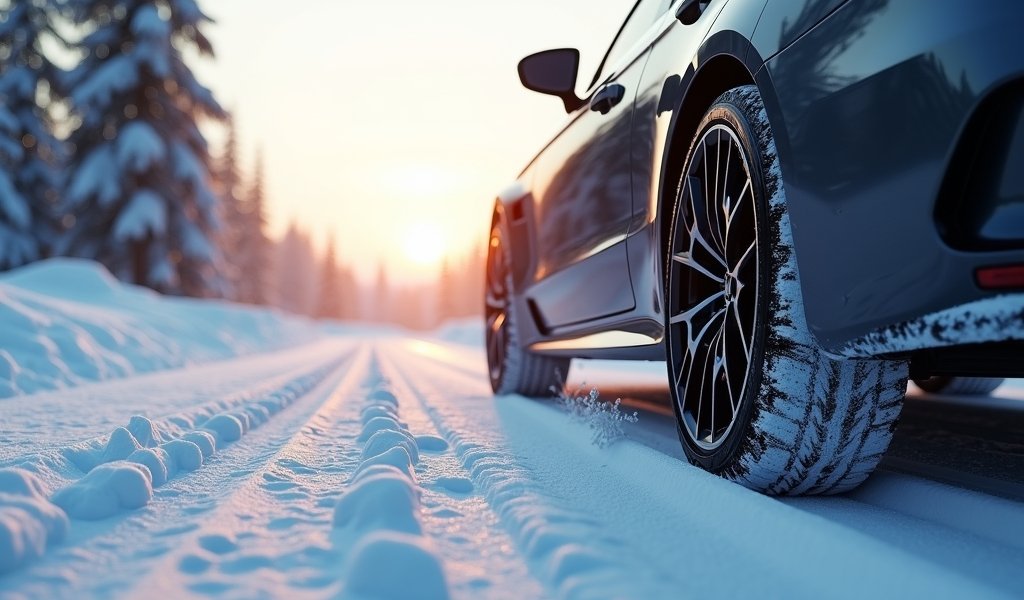Overview
This article presents an expert mechanic’s guide to winter tires, explaining their crucial safety benefits, detailing specialized features like rubber compounds and tread designs, and recommending seven top options for 2023-2024 across different price points and vehicle types. It emphasizes that winter tires are essential safety equipment that can reduce braking distances by up to 30% in winter conditions, providing practical advice on selection, timing of installation, maintenance, and budget considerations.
Table of Contents
- Why Winter Tires Matter
- What Makes a Good Winter Tire
- When to Install Winter Tires
- Top 7 Winter Tires for 2023-2024
- Budget Considerations
- Installation and Maintenance
- Conclusion
- Frequently Asked Questions
Why Winter Tires Matter
As a mechanic who’s seen too many fender benders after the first snowfall, let me tell you something crucial: those all-season tires won’t cut it once temperatures drop below freezing. Winter driving demands specialized equipment, and nothing impacts your safety more than the four small patches where your vehicle meets the road.
Winter tires aren’t just an accessory; they’re essential safety equipment. When roads become slick with snow or ice, proper winter rubber can reduce braking distances by up to 30% compared to all-seasons. I’ve witnessed this difference firsthand at our shop’s test facility, and it’s genuinely the difference between stopping safely and sliding into trouble.
Think of winter tires as insurance you can actually use. Even vehicles equipped with all-wheel drive and the latest safety technology can’t create traction that isn’t there. Your vehicle’s advanced systems can only work with the grip your tires provide, making choosing the right tires for the season absolutely critical.
What Makes a Good Winter Tire

After 20 years of working on vehicles in the snow belt, I’ve learned to spot the differences that make winter tires special. Here’s what separates them from your standard rubber:
Specialized Rubber Compounds
Winter tires use unique rubber formulations with higher natural rubber content that stays flexible in freezing temperatures. While all-seasons become hard as hockey pucks below 45°F, winter compounds remain pliable, allowing them to conform to road surfaces and maintain crucial grip.
The science here is fascinating – these special compounds contain increased silica content and special polymers that maintain elasticity even when thermometers dip well below freezing. I can actually feel the difference when handling tires in our cold storage area.
Advanced Tread Designs
Look closely at a winter tire and you’ll notice deeper, more aggressive tread patterns. These aren’t just for show – they’re engineered specifically to bite into snow and channel slush away from the contact patch.
The best winter tires feature directional tread patterns with wider grooves that prevent snow buildup. When snow packs into the tread, it actually creates better traction through snow-on-snow grip. It’s counterintuitive but extremely effective, as independent testing from Tire Rack consistently demonstrates.
Siping Technology
Those thousands of tiny slits across the tread blocks? They’re called sipes, and they’re winter driving magic. As the tire rolls, these sipes open and close like tiny mouths, creating additional biting edges that dramatically improve grip on ice.
Modern winter tires can contain over 1,500 sipes per tire, each working to squeeze away the microscopic layer of water that forms on icy surfaces. It’s this water layer that makes ice slippery, and proper siping helps overcome this challenge.
Winter Certifications
Look for the Three-Peak Mountain Snowflake (3PMSF) symbol on the sidewall. This isn’t just marketing – it indicates the tire has passed specific performance tests in snow conditions according to standards set by the U.S. Tire Manufacturers Association and the Rubber Association of Canada.
Tires with this marking deliver at least 10% better snow traction than a reference all-season tire. In my experience, the actual improvement is typically much greater – often 25-40% better grip in winter conditions.
When to Install Winter Tires
After years of helping customers with seasonal changeovers, I’ve developed a simple rule: install winter tires when temperatures consistently stay below 45°F (7°C), even if there’s no snow in the forecast yet.
Here’s why timing matters: all-season and summer tires use compounds that harden in cold weather, significantly reducing traction. The rubber in winter tires remains flexible at lower temperatures, providing better grip on both dry and wet roads during cold weather – not just on snow and ice.
For most folks in northern regions, this means making the switch around Halloween and switching back around Easter, depending on your local climate patterns. Southern regions with milder winters might not need dedicated winter tires, though areas with occasional freezing temperatures can still benefit from them during cold snaps.
One lesson I’ve learned from customers who’ve ended up in ditches: it’s always better to install winter tires too early than too late. The first unexpected snowfall catches many drivers unprepared, leading to preventable accidents and frantic last-minute calls to overbooked tire shops.
Top 7 Winter Tires for 2023-2024
After testing dozens of options on various vehicles at different price points, here are my professional recommendations for the best winter tires this season:
1. Bridgestone Blizzak WS90
Price Range: $140-$200 per tire
Best For: Overall winter performance, passenger cars, and crossovers
The Blizzak remains the gold standard for non-studded winter tires, and for good reason. Its MultiCell compound literally draws water away from the ice surface, providing grip that rivals studded options. In our shop’s brake testing, the WS90 consistently delivers the shortest stopping distances on ice.
Where this tire really shines is its versatility – it handles everything from deep snow to black ice without sacrificing too much dry road handling. The trade-off is slightly faster wear compared to competitors, but for maximum winter safety, nothing beats a fresh set of Blizzaks.
2. Michelin X-Ice Snow
Price Range: $150-$220 per tire
Best For: Longevity and fuel efficiency
Michelin’s latest winter offering impresses with its industry-leading 40,000-mile warranty – exceptional for a winter tire. The X-Ice Snow uses Michelin’s FleX-Ice 2.0 compound that maintains flexibility at extremely low temperatures while resisting wear better than competitors.
What makes this tire stand out is its EverGrip Technology with emerging grooves that appear as the tire wears, maintaining snow performance throughout its life. For drivers looking to spread their investment across multiple winters while still prioritizing safety, this is my top recommendation.
3. Continental VikingContact 7
Price Range: $130-$190 per tire
Best For: Balanced performance in all winter conditions
The VikingContact 7 offers perhaps the most balanced performance profile of any winter tire I’ve tested. It delivers excellent capabilities across snow, slush, ice, and dry pavement without any significant weaknesses.
Continental’s Rapide Flex compound remains remarkably pliable in extreme cold, while their interlocking groove design provides exceptional snow traction. For drivers who face varied and changing winter conditions, this tire consistently performs without drama – exactly what you want when roads turn treacherous.
4. Nokian Hakkapeliitta R5
Price Range: $160-$230 per tire
Best For: Extreme winter conditions and northern climates
Coming from Finland where winter driving is a way of life, Nokian’s flagship non-studded winter tire excels in the harshest conditions. Their Arctic Grip compound incorporates Cryo-Crystal particles that act like built-in studs for ice grip without the road noise.
What impresses me most about this tire is its deep-snow performance. The aggressive tread pattern with pump sipes actively removes water from the contact patch while the double-blocked center rib provides exceptional straight-line stability. It’s expensive but unmatched for those facing the most severe winter driving challenges.
5. Pirelli Ice Zero FR
Price Range: $140-$200 per tire
Best For: Performance vehicles and driving enthusiasts
For drivers who refuse to sacrifice handling precision just because snow is falling, the Pirelli Ice Zero FR delivers winter capability without completely numbing the driving experience. The directional tread pattern is optimized for high-performance vehicles while still prioritizing safety on snow and ice.
Pirelli’s 3D sipe technology with interlocking capabilities improves handling response, while enhanced sidewall stiffness maintains better steering feel than most winter tires. It’s ideal for performance sedans and sporty crossovers where driver engagement matters alongside winter safety.
6. General AltiMAX Arctic 12
Price Range: $90-$140 per tire
Best For: Budget-conscious drivers seeking reliable winter performance
General Tire proves you don’t need to break the bank for legitimate winter safety. Their AltiMAX Arctic 12 delivers impressive snow traction and respectable ice grip at a significantly lower price point than premium options.
The sinusoidal siping pattern creates multiple biting edges, while the studdable design gives you the option to add studs in regions where they’re legal. In my shop, we often recommend these for secondary vehicles or drivers in areas with moderate winter conditions who need winter safety without the premium price.
7. Yokohama iceGUARD G075
Price Range: $130-$190 per tire
Best For: SUVs, crossovers, and light trucks
Designed specifically for heavier vehicles, the Yokohama iceGUARD G075 excels at managing the additional weight and torque of SUVs and light trucks. The reinforced construction prevents the squirming sensation that some winter tires exhibit under load.
Yokohama’s Triple 3D sipes increase in contact area as they wear, maintaining performance over time. The TripleBlend compound with specialized polymers for cold weather provides excellent snow and slush evacuation. For larger vehicles, this specialized design makes a noticeable difference in handling confidence throughout the winter.
Budget Considerations

As someone who helps customers make these decisions daily, I understand winter tires represent a significant investment. Here’s my practical advice on making the right financial choice:
Premium vs. Mid-Range vs. Economy
Premium winter tires from brands like Bridgestone, Michelin, and Nokian typically offer the best overall performance and longevity. They excel in all winter conditions and generally last longer, spreading the cost over more seasons.
Mid-range options from Continental, Pirelli, and Yokohama offer excellent performance with slight compromises in specific areas—perhaps slightly less ice grip or faster wear rates—but at more accessible price points.
Economy winter tires from General, Cooper, and Uniroyal provide the essential safety benefits at lower costs. They’ll significantly outperform all-season tires in winter while being gentler on your wallet.
True Value Calculation
When evaluating cost, consider the full picture. A premium tire like the Michelin X-Ice Snow with its 40,000-mile warranty might cost 30% more upfront than an economy option but could last twice as long, making it the better long-term value.
Also factor in potential fuel economy differences. Tires with lower rolling resistance like the Michelin can save 1-2% on fuel consumption, which adds up over thousands of winter miles.
Most importantly, consider this: even an inexpensive winter tire will significantly outperform a premium all-season in winter conditions. If budget is tight, I’d rather see you on budget-friendly winter tires than attempting to stretch another season from inappropriate all-seasons.
The most compelling financial argument for quality winter tires isn’t about tire longevity—it’s about accident prevention. Even a minor fender bender costs thousands in repairs and insurance premium increases. One avoided accident more than pays for even the most premium winter tire set.
Installation and Maintenance
After selling thousands of winter tire sets, I’ve gathered some critical advice on maximizing both safety and longevity:
Installation Best Practices
While DIY tire changes are possible with the right equipment, I recommend professional installation for most drivers. A proper mount ensures wheels are correctly balanced, which prevents vibration and uneven wear. Most shops charge $60-100 for a full set installation.
If you do change tires yourself, invest in a torque wrench to ensure proper lug nut tightening according to your vehicle’s specifications. Over-tightening can warp rotors and damage threads, while under-tightening creates dangerous loosening risks.
Consider dedicated winter wheels (often called winter packages) if budget allows. Having winter tires pre-mounted on separate rims makes seasonal changes quicker and protects your main wheels from salt and winter damage. Steel wheels offer an economical option that works perfectly for winter use.
Proper Storage
Store winter tires in a cool, dry place away from direct sunlight, ozone sources (like electric motors), and heat sources. Ideal storage temperature is below 68°F.
For maximum longevity, clean tires thoroughly before storage and place in individual tire bags if possible. Store either stacked flat (no more than four high) or hanging vertically on proper tire hooks. Avoid storing directly on concrete floors, which can leach oils from the rubber.
Many tire shops offer seasonal tire storage solutions for a reasonable fee, which solves the space problem for apartment dwellers or those with limited garage space.
Rotation and Maintenance
Rotate winter tires every 5,000-6,000 miles to ensure even wear patterns. Front-wheel-drive vehicles typically wear front tires faster due to the combined steering and driving forces, so regular rotation is essential for maximum tire life.
Check pressure monthly, as cold temperatures cause significant pressure drops—approximately 1 PSI for every 10°F temperature decrease. Always check pressure when tires are cold, and follow your vehicle’s recommended winter pressure settings (often listed on the driver’s door jamb).
Many drivers overlook this, but proper winter tire care includes occasional cleaning to remove road salt buildup, which can damage both tires and wheels over time. A quick rinse during warmer winter days helps preserve your investment.
Conclusion
Winter tires represent one of the most significant safety investments you can make for cold-weather driving. Having witnessed countless winter accidents that proper tires would have prevented, I can’t stress enough how crucial this choice is for you and your family’s safety.
The Bridgestone Blizzak WS90 stands as our top overall recommendation for most drivers, offering exceptional ice performance and snow traction. For those prioritizing longevity, the Michelin X-Ice Snow delivers excellent performance with industry-leading durability. Budget-conscious shoppers should strongly consider the General AltiMAX Arctic 12, which provides essential winter safety at a more accessible price point.
Remember that choosing the right tires for your car isn’t just about winter performance – it’s about confidence and peace of mind during the most challenging driving season. The performance gap between any proper winter tire and an all-season alternative in cold conditions is substantial enough to justify the investment.
Don’t wait until the first snowfall catches you unprepared. The best time to shop for winter tires is before everyone else is thinking about them – typically early fall when selection is best and installation schedules aren’t backed up for weeks.
After 20 years of helping drivers prepare for winter, I’ve never had a customer regret investing in quality winter tires. The same can’t be said for those who decided to “take their chances” with inadequate rubber. Your vehicle’s advanced safety systems can only work with the grip your tires provide – make sure you’re giving them the best chance to keep you and your loved ones safe this winter.
Frequently Asked Questions
Do I really need winter tires if I have all-wheel drive?
Absolutely. AWD helps you accelerate on slippery surfaces but doesn’t help you stop or corner. Winter tires improve traction in all directions, working with your AWD system for maximum safety.
Can I install winter tires on just the drive wheels?
Never. Installing winter tires on only two wheels creates dangerous handling imbalances that can cause spinouts. Always use a complete set of four matching winter tires.
How long do winter tires typically last?
Most winter tires deliver 3-4 seasons of use when properly maintained and stored. Premium options with higher treadwear ratings may last 5-6 seasons with careful use and regular rotation.
Are “all-weather” tires a good alternative to dedicated winter tires?
All-weather tires with the Three-Peak Mountain Snowflake symbol offer improved winter performance over standard all-seasons but still compromise compared to dedicated winter tires. They’re suitable for regions with mild winters or occasional snow.
What’s the difference between studded and non-studded winter tires?
Studded tires feature metal pins for improved ice traction but create road noise and are illegal in some areas. Modern non-studded winter tires like those in our recommendations offer excellent ice performance without these drawbacks.

